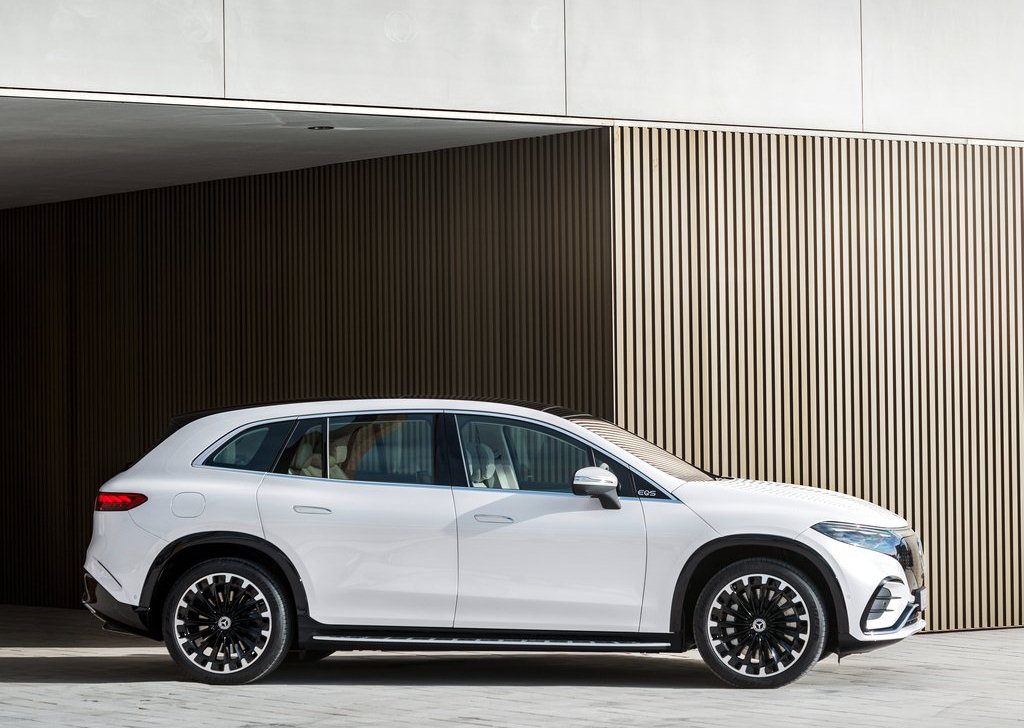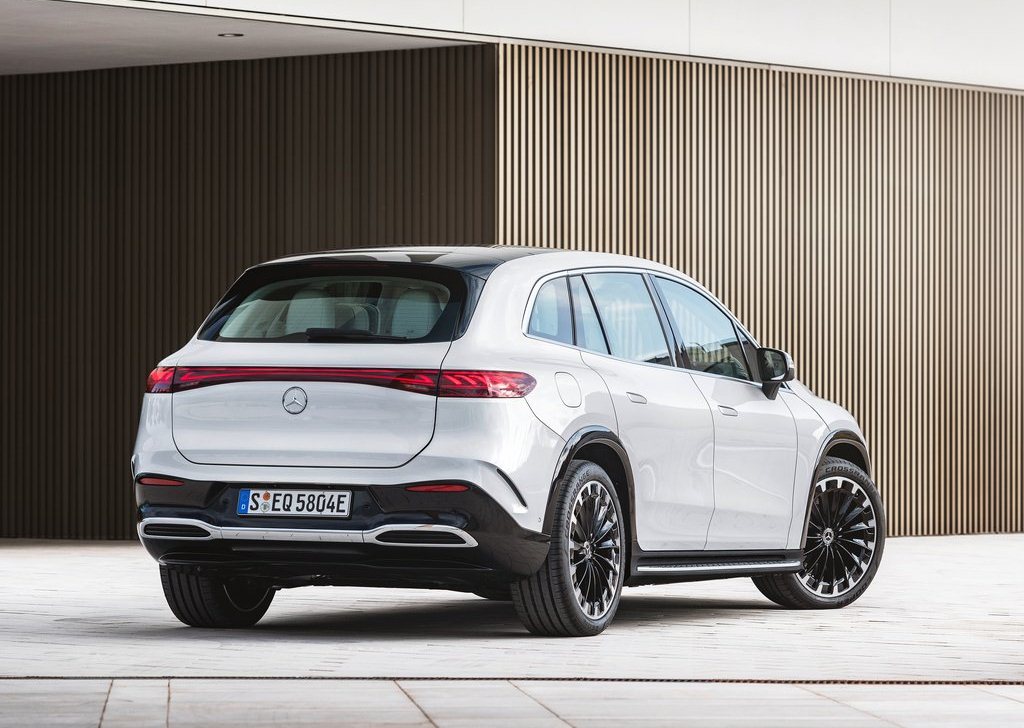With the luxury saloon EQS and the sporty executive saloon EQE, Mercedes-Benz has entered a new, all-electric era in the upper market segments as well. The EQS SUV, the third model series with this architecture developed for electric vehicles, will soon follow. The SUV offers plenty of space, comfort and connectivity for up to seven passengers in its avant-garde, luxurious interior. Thanks to powerful electric motors, responsive 4MATIC all-wheel drive and an intelligent OFFROAD driving mode, the EQS SUV is also capable of tackling light terrain with ease. The new EQS SUV shares the long wheelbase (3210 millimetres) with the EQS Saloon, but is over 20 centimetres higher. The dimensions in detail: 5125/1959/1718 millimetres (length/width/height). The interior dimensions benefit from these generous SUV dimensions and from the advantages of the purpose design tailored to the electric platform. The second row of seats can be electrically adjusted as standard. Up to four golf bags fit in the boot. A third row of seats with two additional individual seats and extensive comfort features for all passengers is available as an option. The EQS Saloon is the current aerodynamics world champion for production cars. Its purpose design with smooth underbody and usually closed radiator shutter was a good starting point for aerodynamic measures on the EQS SUV. The optimisation of SUV-typical flow details led to a hitherto unique combination of spaciousness and aerodynamic efficiency.
The interior dimensions and variability
The new EQS SUV shares the long wheelbase (3210 millimetres) with the EQS Saloon, but is over 20 centimetres higher. The interior dimensions benefit from these generous SUV dimensions and from the advantages of the purpose design tailored to the electric platform. A third row of seats with two additional individual seats and extensive comfort features for all passengers is available as an option. The space offered by the EQS SUV (length/width/height: 5125/1959/1718 millimetres) is generous. Headroom in the first row of seats with sliding sunroof is 1035 millimetres, in the second it is 1030 and in the third 900 millimetres. Shoulder room and elbow room in the first and subsequent rows of seats are also above average. The second row of seats can be electrically adjusted fore and aft by up to 130 millimetres as standard. As a result, the knee room in the second row of seats is between 830 and 960 millimetres - a comfortable level. The backrests of the second row of seats recline electrically: by 14 degrees to the front and 4 to the rear. The corresponding switches are located in the doors on the right and left.
The exterior design
The EQS SUV is the first all-electric premium SUV from Mercedes-EQ. The innovative and holistic design is based on a new vehicle architecture. It differs from vehicles with internal combustion engines at first glance: highest demands on function and aerodynamics are combined with innovative aesthetics in the unmistakable purpose design. Sensual Purity is reflected in generously modelled surfaces, reduced joints and seamless transitions (seamless design). Even as a seven-seater, the EQS SUV impresses with its dynamic proportions. The front is combined into a 'Black Panel' unit. Headlamps connected by a light band and the deep black radiator grille (Black Panel) form the face. While three light dots form the striking daytime running light signet on the EQS Saloon, there are three small triangles on the EQS SUV. Another special feature is the structured surface of the light modules illuminated from behind: A three-dimensional hexagon pattern in combination with the daytime running lights ensures recognition. LED High Performance headlamps are standard, DIGITAL LIGHT with light band is available as special equipment. The exclusive look of the Black Panel radiator grille with the central Mercedes star can be enhanced further still: In conjunction with AMG Line Exterior, it is also available as special equipment with a three-dimensional star pattern (Mercedes-Benz Pattern). This references the original star of the Daimler-Motoren-Gesellschaft company, which was registered as a trademark in 1911. In addition to its unique look, there is also a function behind the Black Panel surface: the various sensors of the driving assistance systems such as ultrasound, camera and radar are integrated. Seamless design is particularly evident in the front design with the reduced joint pattern and an overlapping bonnet. The front bonnet underlines the dynamics of the EQS SUV with power bulges.
Electric drive
With a range of up to 660 kilometres (according to WLTP) and an output of up to 400 kW, the EQS SUV also meets the requirements of a luxury SUV in terms of power delivery. All EQS SUVs have an electric drive train (eATS) on the rear axle, and the versions with 4MATIC also have an eATS on the front axle. In the 4MATIC models, the Torque Shift function ensures intelligent, continuously variable distribution of drive torque between the rear and front electric motors. The modular drive concept allows a wide range of maximum total outputs from 265 to 400 kW. Depending on the vehicle equipment and configuration, WLTP ranges of up to 660 kilometres1 are possible. The electric motors on the front and rear axles are permanently excited synchronous motors (PSM). On a PSM, the rotor of the AC motor is fitted with permanent magnets and therefore does not need to be supplied with power. The magnets - and thus the rotor - follow the rotating alternating current field in the stator windings. In the EQS SUV, Mercedes-Benz uses a so-called pull-in winding for a particularly strong magnetic field. The motor is referred to as synchronous because the rotor turns at the same rate as the magnetic field of the stator. The frequency is adjusted in the power electronics inverters to the speed requirements of the driver. The advantages of this design include high power density, high efficiency and high power constancy. The motor on the rear axle is particularly powerful due to its six-phase design: it has two windings with three phases each.
The battery
The EQS SUV has a lithium-ion battery with up to 12 cell modules and pouch or hardcase cells. Thanks to the 107.8 kWh capacity, sufficient energy can be provided for ranges of up to 660 kilometres according to WLTP. The innovative battery management software, which was developed in-house, allows updates over the air (OTA). This keeps the energy management of the EQS SUV up-to-date. Battery development is a decisive factor in Mercedes-Benz's electrification strategy. After all, the battery is the heart of an electric car and makes a decisive contribution to, among other things, the range and thus the driving characteristics of the electric vehicle. The EQS Saloon marks the launch of a new generation of batteries with significantly higher energy density. The new batteries set standards in terms of performance, efficiency and charging capacity. They also meet the high Mercedes requirements in terms of safety, durability and sustainability. Mercedes-Benz issues a battery certificate for its high-voltage batteries, and thus a performance guarantee to customers: A term of 10 years or 250,000 kilometres with a remaining capacity of 70 percent.
Aerodynamics
After the EQS and the EQE, the EQS SUV is the third Mercedes-EQ to be based on the modular architecture for large electric vehicles. The optimisation of SUV-typical flow details, for example through turbulators and aerodynamically shaped running boards, delivered a hitherto unique combination of spaciousness and aerodynamic efficiency. To this end, the purpose design with smooth underbody and usually closed radiator shutter of the current aerodynamics world champion for production cars EQS was a good starting point, even if an SUV can never achieve the aerodynamic drag values of a saloon. Behind the very good aerodynamic performance is a lot of detail work. Great attention was paid to the development of the non-visible details in particular, for example on the underbody. One of the special features of the EQS SUV is the innovative design of the rear diffuser with a pronounced spoiler lip. The design cancels the undesirable flow interaction of the underbody and the form of an estate car rear end without reducing the angle of departure. For the optionally available running boards, the designers and aerodynamicists were inspired by the underbody of Formula 1 cars. It drops down in the non-visible area on the underside. This directs the airflow behind the wheels and results in a measurable aerodynamic advantage. Because the axles are installed differently than in the saloons, the underbody panelling with the covers for the electric drive trains (eATS) had to be redesigned. This includes a new sealing concept, but also striking details such as the jagged turbulators in the front part of the underbody. They detach the air vortices in a targeted manner. The flow is directed downwards from the wheel wells. Herringbone-shaped air outlets on the rear floor improve the contact of the underbody flow and direct the rear flow in a desired direction.




















![2026 Kia Sportage [EU] Review: A Refined European Crossover with Bold Style and Electrified Options](https://blogger.googleusercontent.com/img/b/R29vZ2xl/AVvXsEgqMRwJE1m90uCMgRSB6oc4bAzmAaKXJlNoCwavK5fXHaphLYY1sUVXdxUC94zuj95CdjDG2SqRnUBYMqta-dapTLIaHhzEdJAS821ldVMQOKfAZNpQlZ5fYTwKzKbKj8ad9QeKlaQPcNLRZ6zaGvuXhsg1kQ6zQCQqYtjmOM8q9u-a7Nl3WYjp773OLXJR/w680/2026%20Kia%20Sportage%20%5BEU%5D_01.jpg)



0 Comments